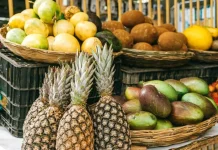
As parents, we all want our kids to grow strong, energetic, and healthy. One of the best ways to support their growth is by introducing superfoods — nutrient-dense ingredients packed with vitamins, minerals, and antioxidants.
These foods don’t just boost energy; they also support immunity, brain development, strong bones, and healthy digestion — all while tasting great. Here are 10 kid-friendly superfoods every parent should add to the family table.
Top 10 Superfoods for Kids
| Superfood | Key Nutrients | Benefits for Kids |
|---|---|---|
| 1. Eggs | Protein, iron, vitamin D, B12 | Builds muscles, supports brain growth, and improves focus |
| 2. Yogurt | Calcium, probiotics, protein | Strengthens bones and supports gut health |
| 3. Blueberries | Antioxidants, vitamin C, fiber | Boosts memory and the immune system |
| 4. Oats | Fiber, iron, B vitamins | Provides steady energy and helps digestion |
| 5. Spinach | Iron, vitamin K, magnesium | Supports bone strength and blood health |
| 6. Sweet Potatoes | Beta-carotene, fiber, vitamin A | Improves vision and skin health |
| 7. Salmon | Omega-3 fatty acids, vitamin D | Enhances brain development and heart health |
| 8. Pumpkin | Vitamin A, potassium, fiber | Boosts immunity and promotes healthy digestion |
| 9. Apples | Fiber, vitamin C, antioxidants | Improves digestion and strengthens immunity |
| 10. Nuts & Seeds | Healthy fats, protein, zinc | Supports brain function and energy levels |
Sources: Healthline – Harvard Health – Nutrition Tips for Children
Why These Superfoods Matter
Each of these foods offers unique health benefits:
Boosts Brain Development
Rich in omega-3 fats and choline, eggs, salmon, and nuts help sharpen kids’ memory, boost learning ability, and improve focus.Builds Strong Bones and Muscles
Yogurt, spinach, and oats deliver calcium, magnesium, and protein that keep growing bones and muscles strong.Strengthens Immunity
Colorful foods like pumpkin, sweet potatoes, and blueberries are rich in antioxidants and vitamin C, which help protect kids from common illnesses.Provides Natural Energy
Oats, apples, and nuts offer complex carbohydrates and healthy fats for steady energy throughout the day — no sugar crash!
Simple Ways to Add Superfoods to Kids’ Meals
- Breakfast: Oatmeal topped with blueberries or banana slices.
- Lunch: Egg and spinach wrap or yogurt parfait.
- Snacks: Apple slices with nut butter or roasted pumpkin seeds.
- Dinner: Grilled salmon with mashed sweet potatoes and steamed veggies.
Tip: Rotate different superfoods each week to keep meals exciting and well-balanced.
Frequently Asked Questions (FAQ)
At what age can a kid start eating superfoods?
You may introduce superfoods once your baby transitions to solid foods, typically around 6 months, after consulting your pediatrician.
Are nuts safe for small children?
Avoid giving whole nuts to toddlers, as they can cause choking. Choose smooth nut butter or finely crushed nuts instead.
How often should kids eat superfoods?
Include at least 2–3 superfoods daily as part of a balanced diet.
Are frozen fruits and veggies still healthy?
Yes! Frozen produce retains most nutrients and is a convenient, budget-friendly option.
How can I get picky eaters to try superfoods?
Mix them into favorite dishes — like smoothies, pancakes, pasta sauces, or muffins — to make them fun and familiar.
Final Thoughts
Superfoods are nature’s way of giving your kids a strong start in life. From protein-rich eggs to antioxidant-packed blueberries, each bite fuels their body and brain.
Encourage variety, keep meals colorful, and make healthy eating a family habit — because small changes today can lead to lifelong wellness tomorrow.
- Why Every Parent Should Add Pumpkin to Their Child’s Diet
- Bitter Melon: A Natural Weapon Against High Blood Sugar
- 10 Outstanding Health Benefits of Bitter Melon (Bitter Gourd)














